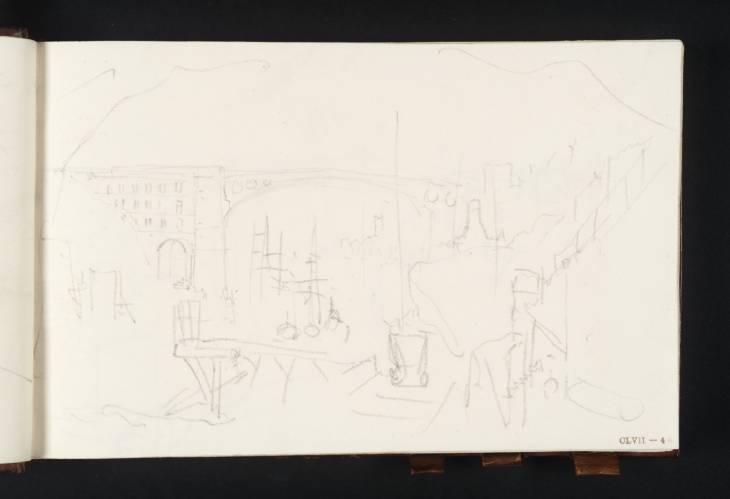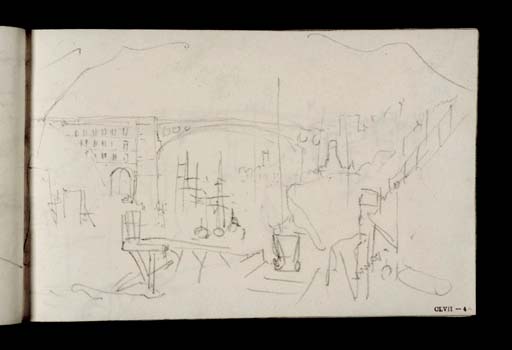Joseph Mallord William Turner Wearmouth Bridge, Sunderland, from Upstream 1817
Image 1 of 2
Joseph Mallord William Turner,
Wearmouth Bridge, Sunderland, from Upstream
1817
Joseph Mallord William Turner 1775–1851
Folio 4 Recto:
Wearmouth Bridge, Sunderland, from Upstream 1817
D12323
Turner Bequest CLVII 4
Turner Bequest CLVII 4
Pencil on white wove paper, 116 x 185 mm
Part watermark ‘J Wh | 1’
Inscribed by John Ruskin in red ink ‘4’ bottom right (now faint)
Stamped in black ‘CLVII – 4’ bottom right
Part watermark ‘J Wh | 1’
Inscribed by John Ruskin in red ink ‘4’ bottom right (now faint)
Stamped in black ‘CLVII – 4’ bottom right
Accepted by the nation as part of the Turner Bequest 1856
References
1909
A.J. Finberg, A Complete Inventory of the Drawings of the Turner Bequest, London 1909, vol.I, p.449, CLVII 4, as ‘Bridge at Newcastle-on-Tyne’.
Turner’s viewpoint is west of Sunderland’s cast-iron Wearmouth Bridge, looking downstream in the direction of the harbour; for its construction and history, see the entry for folio 3 recto (D12321), where it is seen from the opposite direction. The distant tower through the arch appears to be that of Holy Trinity Church. Loose, diagonal strokes at the top left and right reinforce the dynamic of the arch, and presumably indicate clouds, either observed or imagined in terms of a possible finished composition. The sketch is continued with a two very slight strokes on folio 3 verso opposite (D12322). Studies of Sunderland run from folio 1 recto to folio 5 recto (D12318, D12325).
Finberg mistakenly identified the bridge’s setting as Newcastle,1 perhaps by loose comparison with Turner’s Rivers of England view of that city, with its industrial foreground but quite different bridge (see Tate D18144; Turner Bequest CCVIII K);2 the correct identification has been made independently of the present author by Juliet Horsley of Tyne & Wear Museums.3
There is evidence of various industries in the foreground. Just to the right of the bridge is the conical chimney of a glass kiln, still visible in an early photograph of the original bridge by a member of the Backhouse family (Tyne & Wear Museums), and identifiable as the Scott and Horn bottle house.4 Turner appears to show a wagon on a track in the foreground. Another photograph, taken after the partial rebuilding of the bridge in the 1850s, shows the staithes or hurries of the extensive Lambton coal drops here (Tyne & Wear Museums). The first waggon-way from the collieries at Newbottle, a few miles to the south, had been constructed in 1815, shortly before Turner’s visit. The staithes were demolished as late as 1973,5 and the bank at this point is now parkland, with a view of the later railway and road bridges crossing the Tyne. There is a similar view from higher up the south bank on folio 5 recto.
Turner observed comparable scenes on other northern tours, drawing the hurries by the harbour at Whitehaven in Cumbria in 1809 (Yale Center for British Art, New Haven).6 Small coal waggons appear in the background of his 1823 Rivers of England watercolour of Shields, on the River Tyne (Tate D18155; Turner Bequest CCVIII V)7 and the related oil Keelmen Heaving in Coals by Night, exhibited at the Royal Academy in 1835 (National Gallery of Art, Washington).8 His general consciousness of rivers as arenas for commerce and industry is well established.9 Lord Strathmore, whose properties at Hylton near Sunderland and Gibside inland to the west Turner visited at this time, had extensive local coal interests (see the introduction to the tour).
Caption to photograph, Imagine: Tyne & Wear Collections online, accessed 11 August 2009, http://www.imagine.org.uk/details/index.php?id=TWCMS:J586 ; see also related photograph from opposite bank, ibid. http://www.imagine.org.uk/details/index.php?id=TWCMS:J585 .
See James Hamilton, Turner and the Scientists, exhibition catalogue, Tate Gallery, London 1998, fig.95 (apparently mis-identified and dated as ‘The Hurries’ – Coal Boats Loading, North Shields 1822).
Verso:
Blank, save for slight pencil offsetting from folio 5 recto opposite (D12324).
Matthew Imms
February 2010
How to cite
Matthew Imms, ‘Wearmouth Bridge, Sunderland, from Upstream 1817 by Joseph Mallord William Turner’, catalogue entry, February 2010, in David Blayney Brown (ed.), J.M.W. Turner: Sketchbooks, Drawings and Watercolours, Tate Research Publication, December 2012, https://www


